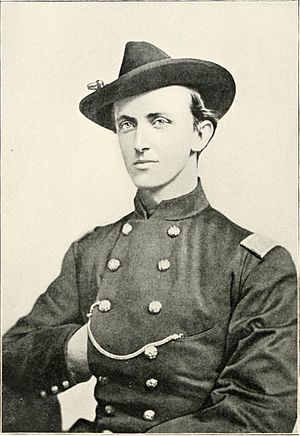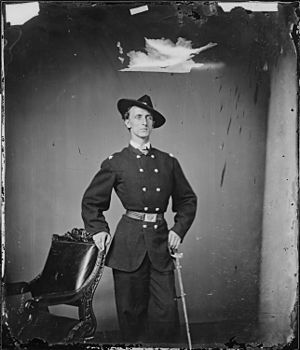William Francis Bartlett facts for kids
Quick facts for kids
William Francis Bartlett
|
|
|---|---|
 |
|
| Born | June 6, 1840 Haverhill, Massachusetts |
| Died | December 17, 1876 (aged 36) Pittsfield, Massachusetts |
| Buried |
Pittsfield Cemetery, Pittsfield, Massachusetts
|
| Allegiance | United States of America Union |
| Service/ |
United States Army Union Army |
| Years of service | 1861–1866 |
| Rank | |
| Unit | 4th Massachusetts Infantry Battalion 20th Massachusetts Infantry |
| Commands held |
|
| Battles/wars | American Civil War |
| Other work | Manager, Tredegar Iron Works |
William Francis Bartlett (born June 6, 1840 – died December 17, 1876) was an important general in the Union Army during the American Civil War. After the war, he became a leader in the iron industry.
Bartlett started the Civil War as a private soldier. He left his studies at Harvard College to join the fight. By the end of the war, he had become a brigadier general. He was also given the honorary rank of brevet major general.
During his time in the army, he led two different groups of soldiers called regiments. He also commanded a brigade (a larger group) and a division (an even larger group). He was hurt four times during the war. After the war, Bartlett managed several iron factories, including the famous Tredegar Iron Works.
Contents
Early Life and Joining the War
William Francis Bartlett was born in Haverhill, Massachusetts. His parents were Charles Leonard Bartlett and Harriett Dorothy Plummer. He went to Phillips Academy and then started at Harvard College in 1858.
The Civil War began while he was still in college. When he heard that the war had started, Bartlett quickly joined the Massachusetts Volunteer Militia as a private.
Service in the Civil War
Bartlett first joined the 4th Battalion Massachusetts Infantry. This group was sent to protect Fort Independence in Boston harbor. At that time, the forts in Boston had no soldiers. They were also not ready for battle.
The 4th Battalion, including Bartlett, worked hard to prepare Fort Independence. They had to turn cannons around to face the water. Bartlett served for 90 days, from April to June 1861.
Joining the 20th Massachusetts
On August 8, 1861, Bartlett became a captain in a new group called the 20th Massachusetts Infantry. He was put in charge of Company I. Many of the officers in this group were Harvard students, so it was known as the "Harvard Regiment."
In September 1861, Captain Bartlett and his company went to Virginia. Their first battle was the Battle of Ball's Bluff on October 21, 1861. This battle was a big loss for the Union Army.
To avoid more losses, Major General George B. McClellan planned a new way to reach the Confederate capital of Richmond. This plan was called the Peninsular Campaign. It involved moving the army by water and then by land.
The 20th Massachusetts and Captain Bartlett were part of this large movement in the spring of 1862. But the plan slowed down when General McClellan decided to surround Yorktown, Virginia. On April 24, 1862, during this time, Captain Bartlett was shot in his left knee. His leg had to be removed. Bartlett went back to Boston to get better. He also finished his degree at Harvard that summer.
Leading the 49th Massachusetts
After finishing college, Bartlett decided to lead a new group of soldiers. On November 12, 1862, he became a colonel and was put in charge of forming the 49th Massachusetts Infantry. This group was meant to serve for nine months.
In late 1862, the 49th Massachusetts was sent to Louisiana. Their goal was to help the Union Army take control of the Mississippi River. Bartlett led his group during the Siege of Port Hudson in Louisiana in the spring of 1863. Because he had only one leg, he had to stay on his horse during battles. This made him an easy target.
On May 27, 1863, during an attack on Port Hudson, Bartlett was shot twice. A bullet broke his left wrist, and buckshot hit his right leg. The doctor was able to save his hand. But these injuries meant he could not lead his soldiers until September 1863. Bartlett left this command on September 1, 1863.
Commanding the 57th Massachusetts
While still getting better from his injuries, Bartlett started to organize another group in the fall of 1863. This group was the 57th Massachusetts Infantry. It was made up mostly of soldiers who had already served in the war.
Bartlett was put in charge of the 57th, which was formed in Worcester, Massachusetts. The group was sent to Virginia before it was fully ready. Bartlett officially became a colonel of the 57th on April 9, 1864.
The 57th Massachusetts joined the IX Corps of the Army of the Potomac. They arrived in time for Ulysses S. Grant's Overland Campaign. This was a series of strong attacks by Union forces in the spring of 1864. The goal was to wear down Robert E. Lee's Army of Northern Virginia.
During this campaign, Bartlett was wounded again. He was hit in the head during the Battle of the Wilderness on May 6, 1864. He returned to Massachusetts to recover. While he was recovering, he was promoted to brigadier general on June 22, 1864. Bartlett went back to the Army of the Potomac in July 1864.
Leading a Brigade
When he returned, Bartlett was put in charge of a brigade. This group was part of the IX Corps and was made up mostly of Massachusetts soldiers. In July, he helped plan the Battle of the Crater. This was a daring plan to break the Siege of Petersburg. Soldiers dug a tunnel under Confederate lines and set off a huge amount of gunpowder.
The explosion on July 30, 1864, worked, but the Union attack that followed was messy and failed. Bartlett's brigade was a big part of the attack. During the battle, his artificial leg was shot off. He could not retreat with his men and was captured by Confederate soldiers.
Bartlett was held in Libby Prison for two months. He became very sick there. He was finally released in a prisoner exchange in late September 1864. It took him several months to recover from his illness.
Commanding a Division
In June 1865, Bartlett returned to the army. This was two months after the Confederate surrender. Even though the fighting had stopped, many Union soldiers were still on duty. Bartlett was promoted to command the 1st Division of the IX Corps on June 17, 1865.
On January 13, 1866, President Andrew Johnson nominated Bartlett for the honorary rank of brevet major general. This rank was confirmed on March 12, 1866. In July 1865, the IX Corps was disbanded. Bartlett stayed in the army for another year before leaving on July 18, 1866.
Life After the War
After the war, Bartlett looked for work managing factories. He became the manager of Tredegar Iron Works in Richmond, Virginia. He also managed the Pomeroy Iron Works and the Powhatan Iron Company.
He eventually settled in Pittsfield, Massachusetts. He died there in December 1876 from tuberculosis. In 1904, a statue of William Francis Bartlett was placed in the Massachusetts State House to honor him.
Images for kids



